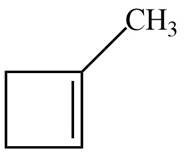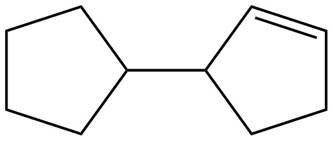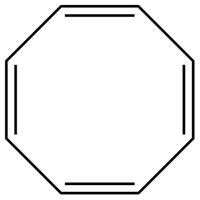
Concept explainers
(a)
Interpretation: The number of rings and number of pi bonds in A is to be determined. And one possible structure is to be drawn.
Concept introduction: Degree of unsaturation is used to determine the total number of rings and pi bonds present in compound by just looking at the molecular formula. It does not specify the total number of rings and total number of pi bonds individually.
Answer to Problem 12.35P
The number of pi bonds and number of rings in A is one. The possible structure is given in Figure 1.
Explanation of Solution
For compound A:
Before hydrogenation, the molecular formula is
The maximum number of
The maximum number of
The number of
Substitute the values of maximum number of
The degree of unsaturation is calculated by the formula,
Hence, the degree of unsaturation before hydrogenation is two.
After hydrogenation, the molecular formula is
The maximum number of
The maximum number of
The number
Substitute the values of maximum number of
The degree of unsaturation is calculated by the formula,
Hence, the degree of unsaturation after hydrogenation is one.
The number of pi bonds in A is calculated by the formula,
Substitute the values of degree of unsaturation before hydrogenation and degree of unsaturation after hydrogenation in the above formula.
Hence, the number of pi bonds is one.
Number of rings is calculated by the formula,
Substitute the values of degree of unsaturation and number of pi bonds in the above formula.
Hence, the number of rings is one.
The possible structure for A is,

Figure 1
The number of pi bonds and number of rings in A is one. The possible structure is given in Figure 1.
(b)
Interpretation: The number of rings and number of pi bonds in B is to be determined. And one possible structure is to be drawn.
Concept introduction: Degree of unsaturation is used to determine the total number of rings and pi bonds present in compound by just looking at the molecular formula. It does not specify the total number of rings and total number of pi bonds individually.
Answer to Problem 12.35P
The number of pi bonds and number of rings in B is one and two respectively. The possible structure is given in Figure 2.
Explanation of Solution
For compound B:
Before hydrogenation, the molecular formula is
The maximum number of
The maximum number of
The number of
Substitute the values of maximum number of
The degree of unsaturation is calculated by the formula,
Hence, the degree of unsaturation before hydrogenation is three.
After hydrogenation, the molecular formula is
The maximum number of
The maximum number of
The number
Substitute the values of maximum number of
The degree of unsaturation is calculated by the formula,
Hence, the degree of unsaturation after hydrogenation is two.
The number of pi bonds in A is calculated by the formula,
Substitute the values of degree of unsaturation before hydrogenation and degree of unsaturation after hydrogenation in the above formula.
Hence, the number of pi bonds is one.
Number of rings is calculated by the formula,
Substitute the values of degree of unsaturation and number of pi bonds in the above formula.
Hence, the number of rings is two.
The possible structure for B is,

Figure 2
The number of pi bonds and number of rings in B is one and two respectively. The possible structure is given in Figure 2.
(c)
Interpretation: The number of rings and number of pi bonds in B is to be determined. And one possible structure is to be drawn.
Concept introduction: Degree of unsaturation is used to determine the total number of rings and pi bonds present in compound by just looking at the molecular formula. It does not specify the total number of rings and total number of pi bonds individually.
Answer to Problem 12.35P
The number of pi bonds and number of rings in C is four and one respectively. The possible structure is given in Figure 3.
Explanation of Solution
For compound C:
Before hydrogenation, the molecular formula is
The maximum number of
The maximum number of
The number of
Substitute the values of maximum number of
The degree of unsaturation is calculated by the formula,
Hence, the degree of unsaturation before hydrogenation is five.
After hydrogenation, the molecular formula is
The maximum number of
The maximum number of
The number
Substitute the values of maximum number of
The degree of unsaturation is calculated by the formula,
Hence, the degree of unsaturation after hydrogenation is one.
The number of pi bonds in A is calculated by the formula,
Substitute the values of degree of unsaturation before hydrogenation and degree of unsaturation after hydrogenation in the above formula.
Hence, the number of pi bonds is four.
Number of rings is calculated by the formula,
Substitute the values of degree of unsaturation and number of pi bonds in the above formula.
Hence, the number of rings is one.
The possible structure for C is,

Figure 3
The number of pi bonds and number of rings in C is four and one respectively. The possible structure is given in Figure 3.
Want to see more full solutions like this?
Chapter 12 Solutions
Organic Chemistry-Package(Custom)
- Determine whether each of the following molecules is a hemiacetal, acetal, or neither and select the appropriate box in the table. CH3O OH OH OH hemiacetal acetal neither hemiacetal acetal neither Xarrow_forwardWhat is the missing reactant R in this organic reaction? N N དལ་ད་་ + R • Draw the structure of R in the drawing area below. • Be sure to use wedge and dash bonds if it's necessary to draw one particular enantiomer. Click and drag to start drawing a structure. ㄖˋarrow_forwardDraw the condensed structure of 4-hydroxy-3-methylbutanal. Click anywhere to draw the first atom of your structure.arrow_forward
- Using the bond energy values, calculate the energy that must be supplied or is released upon the polymerization of 755 monomers. If energy must be supplied, provide a positive number; if energy is released, provide a negative number. Hint: Avogadro’s number is 6.02 × 1023.arrow_forward-AG|F=2E|V 3. Before proceeding with this problem you may want to glance at p. 466 of your textbook where various oxo-phosphorus derivatives and their oxidation states are summarized. Shown below are Latimer diagrams for phosphorus at pH values at 0 and 14: Acidic solution -0.93 +0.38 -0.51 -0.06 H3PO4 →H4P206 H3PO3 H3PO2 → P→ PH3 -0.28 -0.50 → -0.50 Basic solution 3-1.12 -1.57 -2.05 -0.89 PO HPO →→H2PO2 P PH3 -1.73 a) Under acidic conditions, H3PO4 can be reduced into H3PO3 directly (-0.28V), or via the formation and reduction of H4P2O6 (-0.93/+0.38V). Calculate the values of AG's for both processes; comment. (3 points) 0.5 PH, 0.0 -0.5- 2 3 9 3 -1.5 -2.0 Pa H,PO H,PO H,PO -3 -1 0 2 4 Oxidation state, N 2 b) Frost diagram for phosphorus under acidic conditions is shown. Identify possible disproportionation and comproportionation processes; write out chemical equations describing them. (2 points) c) Elemental phosphorus tends to disproportionate under basic conditions. Use data in…arrow_forwardThese two reactions appear to start with the same starting materials but result in different products. How do the chemicals know which product to form? Are both products formed, or is there some information missing that will direct them a particular way?arrow_forward
- What would be the best choices for the missing reagents 1 and 3 in this synthesis? 1. PPh3 3 1 2 2. n-BuLi • Draw the missing reagents in the drawing area below. You can draw them in any arrangement you like. • Do not draw the missing reagent 2. If you draw 1 correctly, we'll know what it is. • Note: if one of your reagents needs to contain a halogen, use bromine. Explanation Check Click and drag to start drawing a structure. 2025 McGraw Hill LLC. All Rights Reserved. Terms of Use | Priva ×arrow_forwardPredict the products of this organic reaction: Explanation Check IN NaBH3CN H+ ? Click and drag to start drawing a structure. D 5 C +arrow_forwardPredict the products of this organic reaction: H3O+ + ? • Draw all the reasonable products in the drawing area below. If there are no products, because no reaction will occur, check the box under the drawing area. • Include both major and minor products, if some of the products will be more common than others. • Be sure to use wedge and dash bonds if you need to distinguish between enantiomers. No reaction. Click and drag to start drawing a structure. dmarrow_forward
- Iarrow_forwardDraw the anti-Markovnikov product of the hydration of this alkene. this problem. Note for advanced students: draw only one product, and don't worry about showing any stereochemistry. Drawing dash and wedge bonds has been disabled for esc esc ☐ Explanation Check F1 1 2 F2 # 3 F3 + $ 14 × 1. BH THE BH3 2. H O NaOH '2 2' Click and drag to start drawing a structure. F4 Q W E R A S D % 905 LL F5 F6 F7 © 2025 McGraw Hill LLC. All Rights Reserved. Terms of Use | Privacy Center | Accessibility < & 6 7 27 8 T Y U G H I F8 F9 F10 F11 F12 9 0 J K L P + // command option Z X C V B N M H H rol option commandarrow_forwardAG/F-2° V 3. Before proceeding with this problem you may want to glance at p. 466 of your textbook where various oxo-phosphorus derivatives and their oxidation states are summarized. Shown below are Latimer diagrams for phosphorus at pH values at 0 and 14: -0.93 +0.38 -0.50 -0.51 -0.06 H3PO4 →H4P206 →H3PO3 →→H3PO₂ → P → PH3 Acidic solution Basic solution -0.28 -0.50 3--1.12 -1.57 -2.05 -0.89 PO HPO H₂PO₂ →P → PH3 -1.73 a) Under acidic conditions, H3PO4 can be reduced into H3PO3 directly (-0.28V), or via the formation and reduction of H4P206 (-0.93/+0.38V). Calculate the values of AG's for both processes; comment. (3 points) 0.5 PH P 0.0 -0.5 -1.0- -1.5- -2.0 H.PO, -2.3+ -3 -2 -1 1 2 3 2 H,PO, b) Frost diagram for phosphorus under acidic conditions is shown. Identify possible disproportionation and comproportionation processes; write out chemical equations describing them. (2 points) H,PO 4 S Oxidation stale, Narrow_forward
